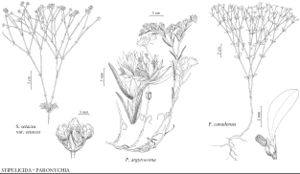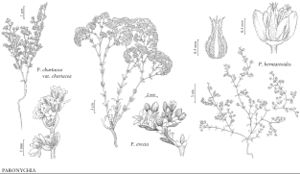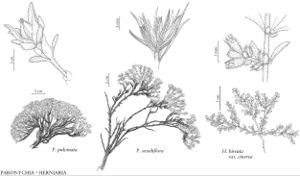Paronychia
Gard. Dict. Abr. ed. 4, vol. 3. 1754.
Herbs, annual, biennial, or perennial, sometimes with woody base. Taproots filiform to stout. Stems prostrate, ascending, or erect, simple or branched, terete to angular. Leaves opposite, connate by stipules from adjacent leaves, petiolate (basal) or sessile (cauline); stipules 2 per node, often conspicuous, white or silvery, subulate to lanceolate or ovate, margins entire or fimbriate, apex subobtuse or acute to acuminate, unlobed or sometimes deeply 2-fid; blade 1-veined, linear to elliptic, oblanceolate, or spatulate, sometimes thickened and succulent, apex obtuse or acute to acuminate or spinose. Inflorescences terminal or sometimes axillary, frequently much-branched or congested cymes, or flowers solitary; bracts paired, dimorphic (resembling leaf-blades and stipules), often concealing flowers. Pedicels erect in fruit. Flowers bisexual or rarely unisexual, some plants also having staminate unisexual flowers, others also having pistillate unisexual flowers, not woolly, with hairs ± straight or tips coiled, 0.1–0.3 mm; hypanthium cupshaped, tapering or expanded distally; sepals (3–) 5, connate proximally, white or yellowish to green or reddish or purplish brown, subulate to linear-oblong, lanceolate, spatulate, or ovate, 0.4–4.5 mm, margins translucent to white, scarious or papery, apex defined by a usually prominent adaxial hood, ascending to slightly descending, rounded to triangular, sometimes absent (P. americana, P. erecta), apex obtuse or rounded, usually with terminal or subterminal cusp, crest, mucro, or prominent awn (often thickened-conic proximally, spinose distally); nectar secreted from within hypanthium; stamens usually 5; filaments distinct or connate proximally with alternating staminodes; staminodes absent or 5, arising from hypanthium rim, subulate to narrowly triangular, filiform, or oblong; styles 1–2 (–3), distinct or often connate proximally 1/10–9/10 of length, subcapitate to filiform, 0.07–3.2 mm, glabrous proximally; stigmas 2 (–3), subterminal or linear along adaxial surface of style-branches, obscurely papillate (50×). Utricles ovoid to globose or rarely 4-angular, membranous, indehiscent. Seeds brown, subglobose to ellipsoid, laterally compressed, smooth, marginal wing absent, appendage absent; embryo peripheral, curved. x = 7, 8, 9.
Distribution
Warm-temperate North America, South America, Eurasia, Africa
Discussion
Species ca. 110 (26 in the flora).
Much of this treatment follows M. N. Chaudhri (1968), the only recent monograph of the genus; we agree with B. L. Turner (1983b) in not recognizing the infraspecific taxa that Chaudhri proposed for North American taxa. We follow L. H. Shinners (1962c) and Chaudhri in including the genus Siphonychia within Paronychia. This disposition is supported by results of the molecular study by B. Oxleman et al. (2002), which indicated that subg. Paronychia and subg. Siphonychia (Torrey & A. Gray) Chaudhri are sister taxa within a strongly supported clade.
We have chosen not to utilize an infrageneric classification of Paronychia. M. N. Chaudhri (1968) recognized three subgenera within Paronychia. Most of our species are included in one of the two sections of subg. Paronychia; within sect. Paronychia, North American taxa fall into three subsections (including five different series within subsect. Paronychia). B. Oxelman et al. (2002) found that Paronychia as presently accepted is polyphyletic, with subg. Anoplonychia (Fenzl) Chaudhri (48 Old World species) clustering with Herniaria. Since their investigation included only eight species of Paronychia, additional study is warranted before splitting Paronychia and, as a logical consequence, revising the infrageneric classification.
Flowers are described here in the closed state; the vast majority seen on Paronychia specimens examined are closed. The flower lengths given include awns (cusps, mucros, crests); sepal measurements do not include the awns; awns are interpreted as originating at the point of the departure of the usually ± horizontal, adaxial hood.
Selected References
Lower Taxa
Key
| 1 | Sepals rounded or with conic to triangular cusp, crest, or mucro, 0.1-0.3 mm | > 2 |
| 1 | Sepals with distinct apical or subapical awn or spine, 0.5-2.1 mm, proximal 1/ 2/ 3 (measured from point of departure of hood) often thickened and ± conic or awn ± lanceoloid and 0.4-2.1+ mm | > 9 |
| 2 | Sepals papery, typically red-brown proximally, white or whitish in distal 1/ 1/ 4, mucronate or not | > 3 |
| 2 | Sepals herbaceous to leathery or rigid, mucronate | > 5 |
| 3 | Sepals not mucronate; plant cespitose perennial (occasionally biennial?); stems typically dimorphic, sterile ones with leaves more closely imbricate than fertile | Paronychia erecta |
| 3 | Sepals mucronate; plants annual or rarely short-lived, noncespitose perennial; stems only fertile | > 4 |
| 4 | Flowers 1.2-2.2 mm, in clusters 2-5 mm wide; sepals 0.6-1.2 mm; styles 1.3 mm or less | Paronychia patula |
| 4 | Flowers 2.3-3.5 mm, in clusters often 5-30 mm wide; sepals 1.5-2 mm; styles 1.5 mm or longer | Paronychia rugelii |
| 5 | Leaf blade margins revolute | Paronychia chartacea |
| 5 | Leaf blade margins flat | > 6 |
| 6 | Plants glabrous | Paronychia canadensis |
| 6 | Plants, at least stems and often hypanthia, pubescent, sometimes sparsely so | > 7 |
| 7 | Flowers briefly constricted above hypanthium; sepal apices broadly rounded, with cusps absent; sepals obovate, 0.4-0.8 mm | Paronychia americana |
| 7 | Flowers not constricted between hypanthium and calyx; sepal apices with cusps 0.1-0.3 mm; sepals linear-oblong to ovate, 0.8-1.3 mm | > 8 |
| 8 | Leaf margins ciliate, at least proximally; staminodes subulate, 0.2-0.3 mm | Paronychia baldwinii |
| 8 | Leaf margins glabrous; staminodes absent | Paronychia fastigiata |
| 9 | Awns and often margins of calyx lobes white, often prominent | > 10 |
| 9 | Awns and margins green to brown or yellowish (awns white but inconspicuous and threadlike in P. ahartii) | > 14 |
| 10 | Awns of calyx lobes ± lanceoloid, often flattened, distinct spine absent; s, w Texas | > 11 |
| 10 | Awns of calyx lobes spinose or ± conic with spinose tip | > 12 |
| 11 | Leaves glabrous; hypanthia with numerous hooked hairs | Paronychia maccartii |
| 11 | Leaves hirtullose; hypanthia with straight hairs | Paronychia wilkinsonii |
| 12 | Awns of calyx lobes spinose, ± erect; plants perennial; Kentucky, Georgia, Tennessee, and east | Paronychia argyrocoma |
| 12 | Awns of calyx lobes ± broadly conic, divergent; plants annual or biennial | > 13 |
| 13 | Stems erect; calyx rather uniformly pubescent with hooked hairs; Louisiana, Oklahoma, Texas | Paronychia drummondii |
| 13 | Stems prostrate; calyx with at least a few decidedly enlarged, hooked hairs; s Texas | Paronychia jonesii |
| 14 | Plants diminutive, annual; stems erect, 0.5-1.2 cm; calyx lobes with linear, herbaceous midrib terminating in white, wavy, threadlike, spreading awn 1.5-2 mm, margins scarious, resembling stipule with erect, split apex apparently representing hood | Paronychia ahartii |
| 14 | Plants if annual, 3-38 cm; calyx lobes lanceolate to ovate with relatively stout awn or spine, margins if scarious, not stipulelike, hoods ± horizontal, adaxial | > 15 |
| 15 | Leaves relatively broad (ovate to elliptic or oblong) | > 16 |
| 15 | Leaves needlelike (linear to subulate or filiform) | > 19 |
| 16 | Plants erect to prostrate, annual | > 17 |
| 16 | Plants cespitose or prostrate, strongly perennial | > 18 |
| 17 | Flowers 3-12 per node along stems and branches, moderately pubescent with hooked hairs proximally; awns of calyx lobes widely divergent, 0.6-0.9 mm; introduced; California | Paronychia echinulata |
| 17 | Flowers 1 or 2 per node in diffuse cymes, glabrous to strigose; awns of calyx lobes straight to slightly spreading, 0.3-0.4 mm; native; Florida, Georgia, South Carolina | Paronychia herniarioides |
| 18 | Plants mat-forming; stems mostly 20-50 cm; leaves ± moderately antrorsely appressed-pubescent; flowers 3-6 per leaf axil along stem, 1.9-2.4 mm; coastal hills; California | Paronychia franciscana |
| 18 | Plants densely cespitose, forming cushions; stems 5-10 cm; leaves glabrous (or minutely ciliolate); flowers solitary, terminal, 2.5-2.8 mm; alpine; Colorado, New Mexico, Utah, Wyoming | Paronychia pulvinata |
| 19 | Plants annual, biennial, or weak perennial, without vegetative shoots or mats or numerous old stems | > 20 |
| 19 | Plants strongly perennial with vegetative shoots and remnants of old flowering stems, caudex woody, branched | > 22 |
| 20 | Calyces of distalmost flowers noticeably exceeded by subtending bracts | Paronychia setacea |
| 20 | Calyces of distalmost flowers longer than subtending bracts | > 21 |
| 21 | Flowers mostly solitary and separate; flowers 1.6-2 mm; c Texas | Paronychia lindheimeri |
| 21 | Flowers mostly clustered; flowers 2.3-3.2 mm; Trans-Pecos Texas | Paronychia monticola |
| 22 | Flowers 1-6, sessile, terminating stems; leaves of sterile and flowering stems appressed, tightly overlapping (“juniperlike”), blades mostly with roundedapex; awns of sepals erect to somewhat spreadin | Paronychia sessiliflora |
| 22 | Flowers 7-80+, pedicellate, in diffuse to compact cymes; leaves of stems spreading, at least moderately spaced, blades with rounded to mucronate or cuspidate apex | > 23 |
| 23 | Sepals prominently 3-veined throughout | Paronychia virginica |
| 23 | Sepals not veined or obscurely so | > 24 |
| 24 | Stems and leaf blades glabrous; awns 1-1.5(-2) mm | Paronychia monticola |
| 24 | Stems and leaf blades puberulent to pubescent; awns 0.4-0.9 mm | > 25 |
| 25 | Calyces gradually narrowing distally; leaf blades 4-7 mm | Paronychia congesta |
| 25 | Calyces ± cylindric to expanding distally; leaf blades 7-25(-34) mm | > 26 |
| 26 | Plants mat-forming with prostrate stems seldom more than 8 cm above ground surface; flowers 2.3-3.5 mm | Paronychia depressa |
| 26 | Plants with erect to ascending stems, 10-30 cm; flowers 1.8-2.8 mm | Paronychia jamesii |
"/10" is not declared as a valid unit of measurement for this property. "/10" is not declared as a valid unit of measurement for this property.


